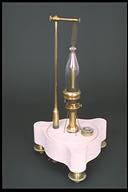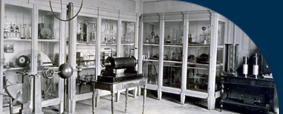|
OUR COLLECTION OF SCIENTIFIC INSTRUMENTS
COSMOGRAPHY, METEOROLOGY, GEOPHYSICS |

 |
Scateni recording sismograph for undulatory shocks |
 |
Sismografo registratore Scateni per scosse ondulatorie |
| Subject: seismology/mechanical recorder for earthquake parameters |
Settore: sismologia/registratore meccanico di alcuni parametri del terremoto |
| Inventory Number: 310 |
Numero di inventario: 310 |
| Achille Scateni [publication] |
Achille Scateni [pubblicazione] |
| Urbino 1883 [publication] |
Periodo di costruzione: Urbino 1883 [pubblicazione] |
| Glass, brass, steel, platinum, mixed and compressed gypsum, ebonite |
Materiale utilizzato: Vetro, ottone, acciaio, platino, impasto di gesso compresso, ebanite |
| 200 X 180 X 280 [mm] |
Dimensioni: 200 X 180 X 280 [mm] |
| |
|
Documentary evidence confirms that this device was invented and built by Achille Scateni, an assistant mechanicianat the “Gabinetto di Fisica” of the University of Urbino from 1860 to 1890. He mentioned the instrument in a public document in Urbino in May 1883. The instrument enabled one to record the time, duration, direction and any other phase of seismic phenomenon. It consisted of a detector (figure), which is in a good state of preservation and which is nearly complete, the recorder, which, unfortunately, no longer available. Displaying only the recording apparatus, Scateni participated in the General Italian Exposition (geodynamic field) held in 1884 in Turin. |
Da alcuni documenti risulta che questo apparecchio fu inventato e costruito da Achille Scateni, assistente meccanico al Gabinetto di Fisica dell'Università di Urbino dal 1860 al 1890. Di esso il medesimo diede notizia in una pubblicazione urbinate del maggio 1883. Lo strumento permetteva di registrare l'ora, la durata, la direzione ed ogni altra fase del fenomeno sismico. Si componeva di una parte rivelatrice (in figura), in buono stato di conservazione e pressochè completa, e di una registratoria di cui, purtroppo, si è persa ogni traccia. Esibendo solo la parte rivelatrice Scateni partecipò con questo strumento alla Esposizione Generale Italiana in Torino (settore geodinamico) tenutasi nel 1884. |
| |
|
Description: the detector is centrally fixed to a triangular base made of compressed white gypsum, which is provided with a small (presently incomplete) magnetic compass; the detector consists of a cylindrical glass bell (which is 12 cm. in length and having a diameter of 3 cm.) that is overturned and balanced on the point of a steel rod, which is placed inside along the axis of the bell. A ring (unfortunately lacking), which slides along it, permits one to lift or to lower its centre of gravity, thereby making it more sensitive to oscillations. The lower edge of the bell is internally coated with platinum and four metal wires are rigidly connected to the rod supporting the bell with a perfect balance; the four wires are placed in the direction of the cardinal points and they communicate with the recording machine through electrical wires of a circuit supplied by a battery. The indicator (which is lacking) consisted of a balance wheel complete with three concentric dials which indicated, towards the internal part of the device, minutes, hours and seconds. On the dial a system of four indicator arms, each with three metalic points, was moved by the same number of electromagnets corresponding to the four wires of the bell’s pin. |
Descrizione: su una base triangolare in gesso compresso, munita inferiormente di tre viti calanti d'ottone e superiormente di una piccola bussola magnetica (incompleta), è fissata centralmente la parte rivelatrice dell'apparecchio, costituita da una campana cilindrica di vetro (lunga 12 cm e con diametro di 3 cm) capovolta e in equilibrio sulla punta di un'asta di acciaio che la percorre internamente lungo l'asse. Un anello scorrevole (mancante) sull’asta, permette di alzarne o abbassarne il centro di gravità e di renderla quindi più sensibile alle oscillazioni. L'orlo inferiore della campana è internamente foderato di platino e all'asta, che la sorregge in perfetto equilibrio, sono rigidamente collegati quattro fili metallici, posti nelle direzioni dei punti cardinali, ciascuno in comunicazione con l'apparecchio “indicatore e registratore” per mezzo di quattro distinti fili elettrici facenti parte di un circuito alimentato da una batteria. L’”indicatore-registratore” (mancante) consisteva in un orologio a bilanciere munito di tre quadranti concentrici destinati a segnare, andando dall’esterno verso l’interno, i minuti, le ore e i secondi. Sul quadrante un sistema di quattro aste indicatrici, aventi ciascuna tre punte metalliche, veniva mosso dalle ancore di altrettanti elettromagneti corrispondenti ai quattro fili del perno della campana. |
| |
|
Function: the first impulse of the earthquake causes the oscillation of the bell that hits against one of the four wires, which are fixed to the rod. The motion is then transmitted to the recorder, which marks the areas of the dials through the points of each indicator arm. |
Funzionamento: il primo impulso del terremoto mette in oscillazione la campana che, battendo contro uno dei quattro fili fissi sull'asta, chiude il circuito, comunicando il suo movimento alla corrispondente asta indicatrice della parte registratoria che, tramite le proprie punte, provvede a marcare le aree di ciascun quadrante. |
| |
|
Bibliography: Pesaro Public record office [1860], Urbino University subsidies, Title 3, Part. 1; Scateni [1883], pp. 1-3, Table 1, 2; Grianti, Mantovani, Vetrano [1990], pp. 109-114; Ferrari [1992], pp. 99-101 |
Bibliografia: Archivio di Stato di Pesaro [1860], Sussidi all’Università degli Studi di Urbino, Titolo III, Fasc. I; Scateni [1883], pp. 1-3, Tav. I, II; Grianti, Mantovani, Vetrano [1990], pp. 109-114; Ferrari [1992], pp. 99-101 |
|
|
|

